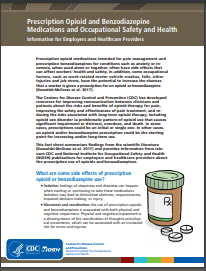Prescription Opioid and Benzodiazepine Medications and Occupational Safety and Health
May 2021
DHHS (NIOSH) Publication Number 2021-116

Prescription opioid medications intended for pain management and prescription benzodiazepines for conditions such as anxiety or insomnia, when used alone or together, often have side effects that can affect workers’ health and safety. In addition, some occupational factors, such as work-related motor vehicle crashes, falls, other injuries and job stress, have the potential to increase the chances that a worker is given a prescription for an opioid or benzodiazepine [Kowalski-McGraw et al. 2017].
The Centers for Disease Control and Prevention (CDC) has developed resources for improving communication between clinicians and patients about the risks and benefits of opioid therapy for pain, improving the safety and effectiveness of pain treatment, and reducing the risks associated with long-term opioid therapy, including opioid use disorder (a problematic pattern of opioid use that causes significant impairment or distress), overdose, and death. In some cases, prescriptions could be an initial or single one. In other cases, an opioid and/or benzodiazepine prescription could be the starting point for increasing and/or long term use.
This fact sheet summarizes findings from the scientific literature [Kowalski-McGraw et al. 2017] and provides information from relevant CDC and National Institute for Occupational Safety and Health (NIOSH) publications for employers and healthcare providers about the prescription use of opioids and benzodiazepines.
Suggested Citation
NIOSH [2021]. Prescription opioid and benzodiazepine medications and occupational safety and health: information for employers and healthcare providers. By Pandalai SP, Schulte PA, Afanuh SE. Cincinnati, OH: U.S. Department of Health and Human Services, Centers for Disease Control and Prevention, National Institute for Occupational Safety and Health, DHHS (NIOSH) Publication No. 2021–116. https://doi.org/10.26616/NIOSHPUB2021116external icon
